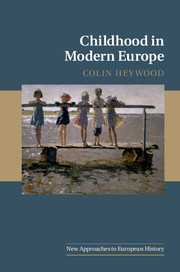Book contents
- Childhood in Modern Europe
- New Approaches to European History
- Childhood in Modern Europe
- Copyright page
- Contents
- Figures
- Acknowledgements
- Introduction
- Part I Childhood in Villages, Eighteenth and Nineteenth Centuries
- Part II Childhood in Towns, c. 1700–1870
- Part III Childhood in an Industrial and Urban Society, c. 1870–2000
- 8 The Scientific Approach to Childhood
- 9 Growing Up during the Twentieth Century, Part 1
- 10 Growing Up during the Twentieth Century, Part 2
- 11 Work and School in an Urban-Industrial Society
- Conclusion
- Select Bibliography
- Index
8 - The Scientific Approach to Childhood
from Part III - Childhood in an Industrial and Urban Society, c. 1870–2000
Published online by Cambridge University Press: 31 August 2018
- Childhood in Modern Europe
- New Approaches to European History
- Childhood in Modern Europe
- Copyright page
- Contents
- Figures
- Acknowledgements
- Introduction
- Part I Childhood in Villages, Eighteenth and Nineteenth Centuries
- Part II Childhood in Towns, c. 1700–1870
- Part III Childhood in an Industrial and Urban Society, c. 1870–2000
- 8 The Scientific Approach to Childhood
- 9 Growing Up during the Twentieth Century, Part 1
- 10 Growing Up during the Twentieth Century, Part 2
- 11 Work and School in an Urban-Industrial Society
- Conclusion
- Select Bibliography
- Index
Summary
- Type
- Chapter
- Information
- Childhood in Modern Europe , pp. 175 - 194Publisher: Cambridge University PressPrint publication year: 2018

